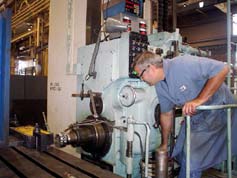
Handy Links
SLAC News Center
SLAC Today
- Subscribe
- Archives: Feb 2006-May 20, 2011
- Archives: May 23, 2011 and later
- Submit Feedback or Story Ideas
- About SLAC Today
SLAC News
Lab News
- Interactions
- Lightsources.org
- ILC NewsLine
- Int'l Science Grid This Week
- Fermilab Today
- Berkeley Lab News
- @brookhaven TODAY
- DOE Pulse
- CERN Courier
- DESY inForm
- US / LHC
SLAC Links
- Emergency
- Safety
- Policy Repository
- Site Entry Form

- Site Maps
- M & O Review
- Computing Status & Calendar
- SLAC Colloquium
- SLACspeak
- SLACspace
- SLAC Logo
- Café Menu
- Flea Market
- Web E-mail
- Marguerite Shuttle
- Discount Commuter Passes
-
Award Reporting Form
- SPIRES
- SciDoc
- Activity Groups
- Library
Stanford
Around the Bay
SLAC's Machine Shop Builds the Unique
 Much of the hardware in use at SLAC is not commercially available—thankfully, perhaps. But because you can't buy a particle accelerator at Home Depot, constructing one requires making many of the components from scratch.
Much of the hardware in use at SLAC is not commercially available—thankfully, perhaps. But because you can't buy a particle accelerator at Home Depot, constructing one requires making many of the components from scratch.
Since the lab's inception, machinists on site have tooled many of the key components in use around SLAC. Doing so requires many different kinds of tools, some quite sophisticated, and some older than the lab itself.
The most sophisticated pieces of machining equipment are the Computer Numerical Control (CNC) milling machines. CNC operators can quickly zap out high-precision pieces from digitized plans sent over SLAC's computer network, enabling machinists, physicists and engineers to collaborate to produce complex parts.
But not all of the unique machining facilities are new. Building the linac accelerator structure, for instance, required a specialized facility for brazing copper. Once the high-precision copper cylinders that make up the linac were partially assembled, sections were baked for days at a time inside towering, 20-foot-tall furnaces that blast the copper with hydrogen. This process melds the individual segments into one solid machine part, ensuring a proper vacuum once the chamber is finally assembled. This brazing facility is still in use today, and SLAC often lends out its use to other labs in need of such equipment.
SLAC's cleaning and plating lab is also extensively utilized by outside industrial interests. This truly unique lab boasts the Bay Area's most extensive electroplating facility, serving users from around the U.S. and the world who regularly make use of the hardware and technical expertise developed through 40 years of experience.
Perhaps the most venerable—and hulking—pieces of equipment at SLAC is the enormous floor mill in the Heavy Fabrication building. Standing more than 15 feet tall, this behemoth was built in the 1950s and is purported to have seen use building tanks in Hawaii just after World War II.
A few of SLAC's machine shops are available to users and staff members who are trained in the use of milling equipment. Interested individuals must first demonstrate their machine-shop proficiency in a short series of written tests and a practical. To find out more, e-mail Craig Jordan.
—Brad Plummer
SLAC Today, September 11, 2006
Above image: SLAC machinist and self-described "grease monkey" Mark Williams operates the World War II era floor mill, formerly used to build tanks in Hawaii. (Click on image for larger version.)